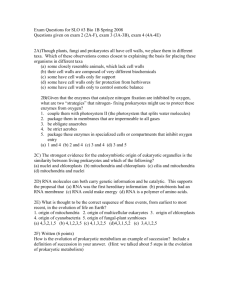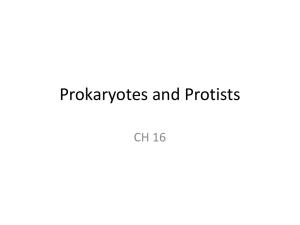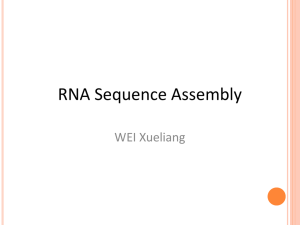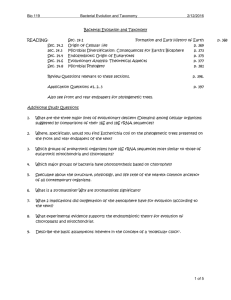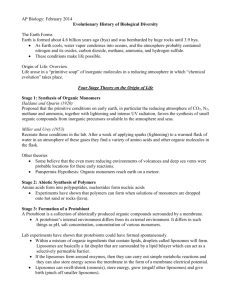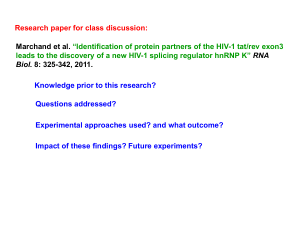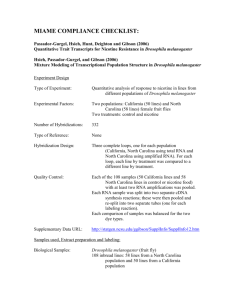Chapter 19 - Microbiology and Molecular Genetics at Oklahoma
advertisement
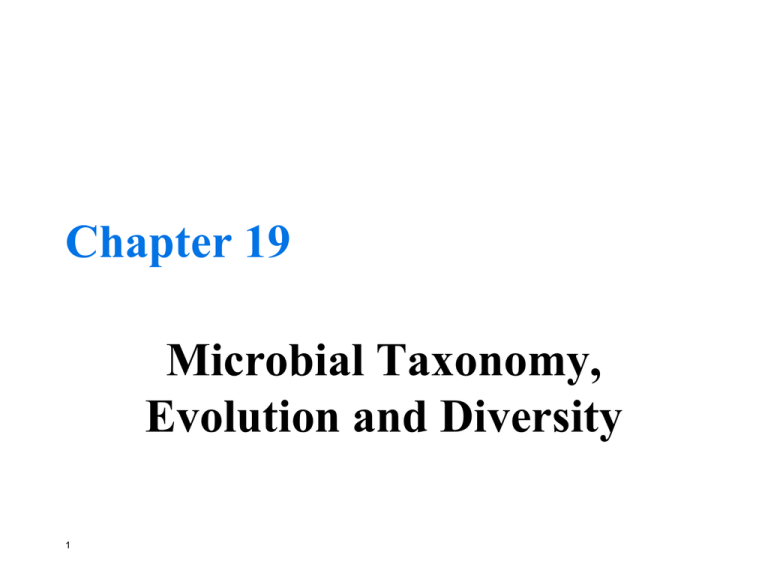
Chapter 19 Microbial Taxonomy, Evolution and Diversity 1 Microbial Evolution • Planet earth is estimated to be 4.5 – 4.6 billion years old • First direct evidence of cellular life discovered in 1977 in the Swartkoppie chert. – microbial fossils ~3.4 billion years old 2 Figure 19.1 3 The First Self Replicating Entity: The RNA World • Pre-cellular life may have been an RNA world because of the capacity of RNA to both replicate and catalyze chemical reactions ((ribozymes) • RNA could have given rise to structurally similar double stranded DNA 4 More Evidence supporting the RNA World • The energy currency of the cell is ATP, a ribonucleotide • RNA can play a role in gene expression 5 Evidence used against the RNA World hypothesis • The early hot, anoxic atmosphere on earth would prevent the stable formation of RNA precursors • RNA is not a stable molecule • Ribozyme involved in RNA replication has not been found 6 Early Cellular Life • FeS-based metabolism used by some archaea may be remnant of early form of chemiosmosis • Photosynthesis also thought to have evolved early in Earth’s history – fossil evidence places evolution of cyanobacteria and oxygenic photosynthesis to ~3 billion years ago – what appear to be fossilized remains found in stromatolites and sedimentary rocks • stromatolites – layered rocks formed by incorporation of mineral sediments into microbial mat 7 Figure 19.2 8 The Three Domains of Life • Carl Woese and George Fox using the nucleotide sequence of the small subuit ribosomal RNAs (rRNAs) determined that all living organisms belong to one of three domains – Archaea – Bacteria – Eucarya 9 Table 19.1 10 The Evolutionary History of Microbes • The universal phylogenetic tree – based on the rRNA sequence from three domains of life – evolutionary relationships based on rRNA sequence comparisons – the root of the tree suggests that the three domains have a single common ancestor, but Archaea and Eucarya evolved independently of the Bacteria 11 Figure 19.3 12 Genome Fusion Hypothesis • Attempts to explain evolution of the nucleus • Claims the combining of certain archaeal and bacterial genes resulted in the formation of a single eucaryotic genome • Origin of nucleus is still unresolved 13 The Endosymbiosis Hypothesis • Claims that endosymbiosis was responsible for the origin of mitochondria and chloroplasts – both organelles have bacteria-like ribosomes – most have a circular chromosome 14 Mitochondria • Believed to be descended from an aproteobacterium – became engulfed in a precursor cell – provided essential function for host • engulfed organism thought to be aerobic, thereby eliminating oxygen toxicity to the host cell • host provided nutrients and a safe environment for engulfed organism 15 More About Mitochondria and Chloroplasts • Engulfed organisms – endosymbionts which evolved into mitochrondria • Chloroplasts are also thought to have evolved from endosymbionts in a similar process 16 Hydrogen Hypothesis Another endosymbiosis Theory • Asserts that the a-proteobacterium endosymbiont was an anaerobic bacterium that produced H2 and CO2 as fermentation end products – hosts lacking external H2 source became dependent on endosymbiont which made ATP by substrate level phosphorylation – symbiont ultimately evolved into a mitochondrion or a hydrogenosome (organelle found in protists that produce ATP by fermentation) 17 Hydrogenosomes of Trichomonas vaginalis Figure 19.4 18 Serial Endosymbiotic Theory (SET) • Put forth by Lynn Margulis and colleagues • Suggests eucaryotes evolved in a series of discrete endosymbiotic steps starting with motility and followed by nuclei and mitochondria 19 Evolutionary Processes • Anagenesis (microevolution) – small, random genetic changes over generations which slowly drive either speciation or extinction, both of which are forms of macroevolution • Punctuate equilibria – a phenomenon caused by the slow, steady pace of evolution being periodically interrupted by rapid bursts of speciation due to abrupt environmental changes 20 Figure 19.5 21

